Level of surfing
Advanced
Quality of surf
Excellent
Call code
1
Net code
co
Area
29311
Coastline
2,450 km
Climate
Tropical, varying by elevation
Hazards
Expensive, Overcrowded Surf Breaks
Best Months
January - December
Population
1211537
Currency
UD Dollar
Time Zone
(UTC-10)
Special Requirements
None
introduction
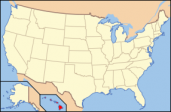
Huebi: Map of USA with Hawaii highlighted; 9 June 2006
Thought to be the birth place of surfing and a mecca for all surfers who should, at least once in a lifetime, visit here to see what it's all about.
Hawaii is an archipelago of several islands across 1500 miles located nearly in the centre of the pacific ocean and marks the northeastern corner of Polynesia. It is the 50th state of the US and Honolulu is the capital and largest city of the group of islands. It's situation is on a hot spot of volcanic action and the newer islands are still growing.
It's religion is as diverse as its population, the largest percentage being Christian at 28.9% followed by Buddhist at 9% and then several other followings such as hawaiian, Jewish, Druid, Hindu, Muslim, Sikh and Scientologist making up the remainder.
The main Language of Hawaii is Hawaiian Creole English, often referred to as Pidgin English, followed by Tagalog (Wikang Filipino) and Japanese.
history

Great painting from the Hawaii State Archives; King Kamehameha I; 06.07.2004
It is thought that the first settlers to arrive in on Hawaii were the Polynesians from the Marquesas in around the fouth century followed by the the arrival of the people of Raiatea and Bora Bora in the eleventh century. The first recorded European contact with Hawaii was that of Captain James Cook from Great Britain in 1778.
During the late 1700's Hawaii was involved in a great struggle for power among it's own native chiefs and after many battles it all ended in 1795 and all inhabited islands were subjugated under one ruler, King Kamehameha the Great. His dynasty ruled over Hawaii until 1872. After King Kamehameha's death Lunalilo was elected ruler until his death in 1874. This led to riots over power again and the U.S. and British armies landed to try and keep the peace and elected King Kalakaua as ruler until his death in 1891. King Kalakaua's sister Liliʻuokalani replaced him on the thrown. In 1893 a group of Americans and Europeans overthrew the Queen and seized control of the government and became the Republic of Hawaii until 1898 when the Republic was annexed to the United States and became US territory.
surfing
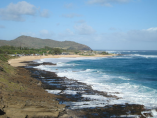
Glenn Cando: Sandy Beach, Oahu; 2006
A pitching deck, the creak of well worn timbers, the cracking of sail and canvas...tied to the mast. Things have changed a little I guess from when Jack London and Josef Conrad wrote their haunting Pacific infused epics but it hasnt changed everythwhere. There are corners of this earth where that mythos still holds true, and most of those corners are here in the South Pacific.
The main source of swell here is from the intense lows that circle the earth south of Australia, these lows spin off northwards with blessed regularity, peppering the entire region with generous SE to SW groundswell from March to September. Australia and New Zealand see the bulk of these swells. These countries cast a very tall shadow across the rest of the Pacific and hence many other islands in their wake can suffer from swell difusion. December to February is cyclone season. Unpredictable cells can deliver swell in a 360 radius, lighting up rarely breaking reefs and points facing every conceivable direction.
The South Pacific trade winds are some of the most consistent in the world, generally from the East with slight seasonal variation. This is the largest Ocean on the planet and these winds easily generate regular rideable swell. Onshore conditions can be a problem on east facing coastlines but peeling yourself out for an early surf will usually bring some relief.
In the North Pacific it is the intense lows descending from the Aleutians that deliver NE to NW swells from October to March. Hawaii is ideally placed to make best use of this energy but other coastlines in the region have their own less publicised and far less crowded gems.
Jun to October also sees rarer hurricane swell radiate out from southern Mexico. This energy is often felt right throughout Polynesia. With so many energy vectors at work it is very hard not to find a wave in Hawaii, just make sure you find something customised for your own skill, experience and level of surf fitness.
travel
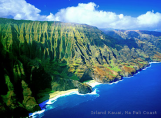
Julius Silver; Kauai; 12.03.2006
When travelling to Hawaii from the U.S. mainland it will be treated as a domestic flight and a passport won't be necessarily be needed, however a good form if photo ID will, the flight will take around 5 Hours. There are many flights to and from most major and small airports on the west coast of the U.S. The carrying of any organic material into Hawaii is strictly prohibited and heavy penalties apply.
All international flights land at the main airport at Honolulu on the island of Oahu and come in from most major Pacific rim cities.
There are four inter-island domestic flight operators in Hawaii flying between all the major islands and cities every day of the week and are very well priced.
There are a number of companies that offer cruises to Hawaii from the west coast of the U.S. mainland if time is not too much of an issue, or you can organise a cruise around the islands upon arrival.
weather
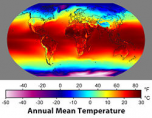
Robert A. Rohde: Annual Average Temperature Map, 15 February 2008
The most prominent feature of the circulation of air across the tropical Pacific is the persistent North East trade-wind flow which is the outflow of air from the the Pacific Anticyclone which forms part of the subtropical region of high pressure, which is typically located well north and east of the Hawaiian Island Chain. As the ridge moves north and south with the sun reaching its northern-most position in the Hawaii summer from May to September when the trades are prevalent almost all of the time. From October through April, the main zone of the trades is located south of Hawaii, but still affect the islands much of the time, though with less frequency. Air temperature is largely dependent on solar radiation and shows a daily variation range of less than 10 °C in the Hawaiian Islands. Seasonal variation is strongly ameliorated by the marine influence on the climate.
Summer (May-September)
The Summer season of only five months is the warmer season with trade winds dominating. Average wind speeds are the highest during this period when speeds are 10-20 knots north-easters. Precipitation is rare, occurring mainly at night along the windward coasts and higher elevations, and so this is the drier season in terms of average monthly rainfall, except on the Kona Coast (leeward coast) of the Island of Hawaii. Monthly mean air temperature ranges between 25°C to 27°C.
Winter (October-April)
Winter is also characterised by north-east to east trade winds but to a much lesser extent than summer. These winds are cross to offshore on the North Shore of Oahu and help to turn on epic conditions. Major storm systems associated with fronts occur during this time of year bringing heavy rain and strong winds, but are not as intense as those of the mid-latitudes. Air temperatures are slightly cooler at 24°C to 26°C, and the trade winds are often interrupted by other winds that see an increase in cloudiness and shower activity. Also at this time of year, a south-westerly wind called the Kona Wind can form and bring more widespread and prolonged precipitation than in a cold-front storm. However winds from this direction also make other surf spots, normally onshore, an option.
where to stay
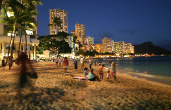
Kelvin Kay; Waikiki Beach at night; 08.07.2006
You can find any type of accommodation you can think of in Hawaii from the luxurious high rised hotels that line the beach front in Waikiki to camping out in remote state parks, it's all here and you can spend as little or as much as you want - within reason of course. Pre booking is advised where possible to avoid disappointment around major holiday periods such as Christmas and New Year.
what to pack
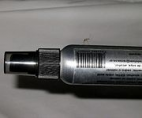
VanTucky: A mosquito on a bottle of repellant; 4 May 2007
Take everything you may need, but don't take too much. Simple loose clothes for the hot weather. Bottles with water, camera, lots of good sunscreen, a hat and sunnies. Good walking shoes or maybe sandals will do as well.
Make sure you pack an adapter (will allow you to plug an appliance designed for one type of outlet into another type of outlet), first aid kit and some medicines that you personally need, because a prescription can be extremely expensive. A map will be very helpful!
So take your camera and make sure you have enough space on the card or plenty of films with you.
dangers and warnings
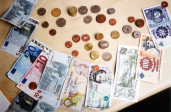
Peregrine981; Money; 20.04.2005
While Hawaii is considered safe compared to many mainland states, it still does have some violent crime rates and theft can be a problem. Be vigilant at all times and keep valuables and money locked away and out of site, take particular care when camping. Single women shouldn't walk off the beaten track in big cities at night. Just use your common sense and you'll be fine.
restaurants, shopping and nightlife
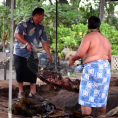
Adam: Roasted Pua'a, Kona; 12.08.2005
Eating
Much like Hawaii's culture the cuisine here is a medley of different tastes from around the world fused together, with main influences from traditional Hawaiian, Portugese, American, Japanese and Asian Pacific flavours. Local specialities include fruit such as fresh pineapple, mango, bananas and local coffee grown on the Big Island as well as fresh fish and beef from the cattle ranches of Maui.
A typical Hawaiian meal is known as a 'Plate Lunch' and may consist of a fresh meat or fish along with a couple of scoops of rice and a macaroni salad. Also worth keeping an eye out for is the traditional polynesian imu pit oven feast. This is a sunken oven in the ground heated with glowing volcanic stones and used to cook a whole pig along with maybe fish and veg - delicious!
Shopping
The largest shopping centre in Hawaii is the Ala Moana Centre in Honolulu, it has over 200 stores of all the top brand names in fashion wear as well as shops selling all the traditional Hawaiian shirts you want to look truly snazzy in front of your mates upon return home
You'll also find the Royal Hawaiian Shopping Centre in Waikiki has many more designer outlets as well jewellery stores and souvenir shops so you can shop til your hearts content.
Nightlife
Searching for entertainment in Hawaii? In addition to the traditional luaus and hula shows, Hawaii has a thriving scene of art, theatre, concerts, clubs, bars, and other events and entertainment.
what to do when it's flat
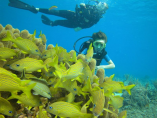
Luist: Scuba; 24.12.2004
If the surf does go completely flat then you're pretty unlucky, however, there are still a myriad of activities to amuse yourself and fend off the flat day blues in Hawaii. These islands are home to some of the finest dive sites in the worldoffering all manner of in-your-face tropical fish, turtles, corals etc and if you're not qualified to scuba dive then the snorkelling can be just as good and a fraction of the price.
Kayaking is also very popular in Hawaii and a great way to explore the coastline and seek out potential 'secret surf spots'. You can also go fishing with one of many charter companies as well as hike, bike, and horseride - or even go skydiving and hangliding for the most daring of you. You certainly won't get bored.
useful phrase guide
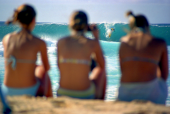
Matt Smith/Crystalbluephotography.com; Wahines on the beach at pipe; Dec 2000
Some useful local lingo:
Hello - Aloha!
Goodbye - Aloha!
Love - Aloha!
Thankyou - Mahalo
Woman - Wahine
Man - Kane
Child - Keiki
Caucasian - Haole






